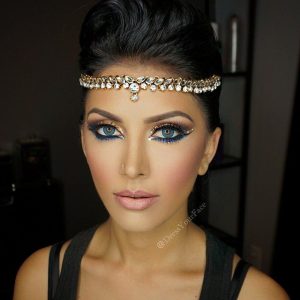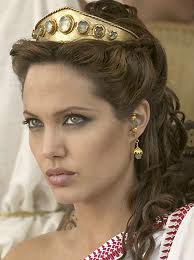The word cosmetic has been derived from the Greek word, Kosmetika and the term for make up was Kommotikon. The usage of make up by the ancient Greeks is even mentioned in the Homerian epic, Iliad and Odyssey.
The ancient Greek women were known as well as praised for their beauty. As a matter of fact, Greek women often used makeup to accentuate their beauty. There is also evidence which points to the fact that ancient Greek women used makeup.
For instance, the paintings on the walls and palace Fresco in Knossos, the royal city of ancient Greece, and the island of Crete which is as old as a 1500BC stand as a testimony to the use of makeup by the ancient Greek women. However, since Ancient Greek Makeup was extremely expensive only rich, wealthy women could afford it.
The ancient Greek Beauty standard

Women in ancient Greece were no different to the women of today when it comes to beauty. The imagery of an ideal woman or a beautiful woman was even present more than 3000 years ago. White skin was a sign of wealth and not using Greek makeup.
It proved that the woman didn’t have to work for hours in the sun. Hence a tanned skin was a sign of poverty while a pale and porcelain skin was a sign of prosperity.
Ancient Greek skin products
The ancient Greek idea of beauty comprised of pale skin, gold locks and natural makeup which is pretty much similar to even today’s modern age Greek women. Pale skin signified prestige and beauty.
Hence, in order to lighten the shade of their skin, ancient Greek women used white lead. A white wrinkle-free skin could be obtained by applying a paste of white lead dissolved in water. This paste would then be applied to the face, neck, shoulders, and arms.

Subsequently, white chalk replaced white lead. One of the major advantages of using chalk was that it could easily as well as quickly be removed. Apart from this, ancient Greek women also used honey to moisturize their skin and olive oil to make the skin shinier.
Ancient Greek Makeup
Minimalistic Ancient Greek Makeup was the key to the beauty of the ancient Greek women. This was done in order to keep their look as natural as possible. Apart from this bright colored lipsticks were also popular and in vogue.
Lipstick was basically a paste consisting of red iron oxide and ochre clays or olive oil with beeswax. Sometimes the red colored powder was also prepared from crushed mulberries, flowers or seaweed.
A product named rouge was used for the checks to make it seem white and the skin pale. Even men were used to using skin care products. The rouge was made of red ochre or a dye that had to be extracted from a certain type of lichens.

Eyes Makeup of Ancient Greece
Another belief which was popular among the ancient Greeks was that connected eyebrows known as unibrows were considered to be a sign of beauty. Hence, the ancient Greek women would decorate their eyes with dark powder in order to make the eyebrows look joint or connected. If they did not have a connected eyebrow they would draw them to create an illusion or artificial unibrows.
Eyeshadows were made up of olive oil properly mixed with ground charcoal. Noblewomen applied a somewhat bold makeup and so these noblewomen applied dark eyeliners, eyebrow colors, and eyeshadow which were produced from soot. Eyes and eyebrows were accentuated with the help of sweeping lines and dark outlines. There were also eye liners and eyebrow paints made from kohl power containing soot, Antigone, saffron or ash.
Ancient Greece Hair
Ancient Greek women took special care of their hair. While the women slaves had short hair, free women had long tresses of hair. However, once a woman got married she would tie her hair in a bun. Different types of hair accessories like a diadem, jeweled combs, hairpins, and such other accessories were very much in vogue. During the Hellenistic period, women not only learned but also mastered the technique of artificially waving and curling their hair.
Applying vinegar and standing under the sun were the two most commonly used remedies for lightening the shade of the hair. Additionally, olive oil was also used as a part of the conditioning treatment of the hair. This not only moisturized their hair but made them soft and shiny.
The practice of dying their hair was common in ancient Greece. There were mainly two types of dyes: first one was used to make the hair darker, and these dyes were extracted from leeches made to rot in wine for about 40 days while the second type was used to make the hair white or paler, which was actually a mixture containing beechwood ash and goat fat.

Apart from all these cosmetic, precious oils, perfumes, cosmetics, beauty unguents etc were also extremely popular. Sale and export of these constituted a major source of revenue for the ancient Greeks.
Additionally, in the 7th and 8th century BC, the Corinthian, Rhodian as well as the East Greek traders dominated the markets with the export of perfume flasks and cosmetic containers. It was during the same period that Athens emerged as the cultural city-state with the establishment of the mercantile center in which several perfume manufacturers set up their shops.
Make up practices
The Greeks writers used to vilify make-up as a product which was used by Lowe class women or by prostitutes. But this could not stop them from using it anyway as it was very popular among people from every walks of life, single or married and especially among women.
The ancient Greeks even used to place cosmetic products within the burials of the dead. Jugs known as Lekythoi was specially dedicated for being used as a holding for grave goods
Many products used by the ancient Greeks were actually very toxic for the skin. The lead products used as skin lighter had very adverse effects in the long run.
The weirder the products the more popular they got. The make-up and cosmetics were made with a wide range of exotic products. Ash was used as a substance to clean teeth. Ingredients such as snail ash were applied to remove freckles, grease from sheep wool was used for making face cream and even excrement from lizards was rubbed into the skin to remove blemishes and wrinkles.